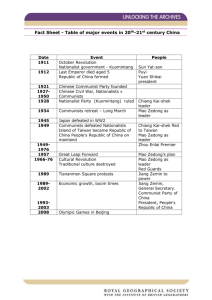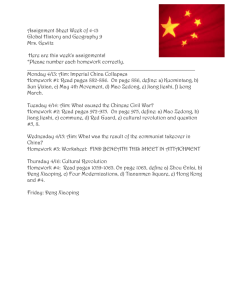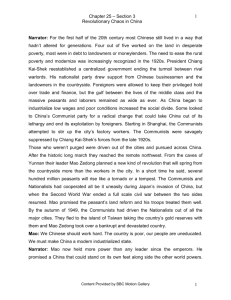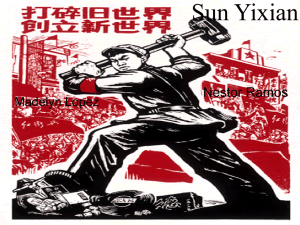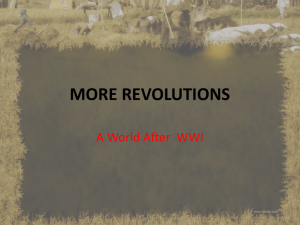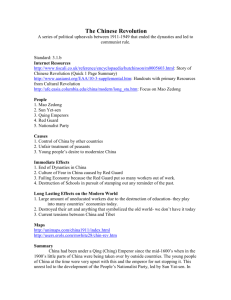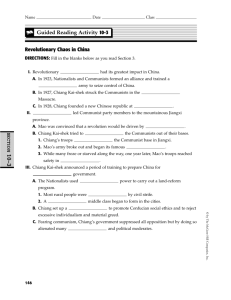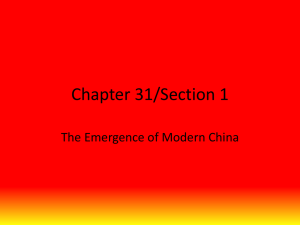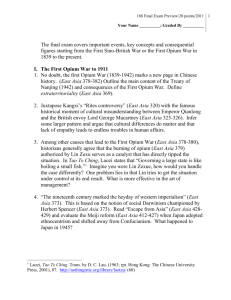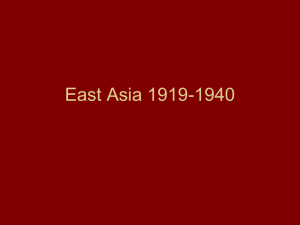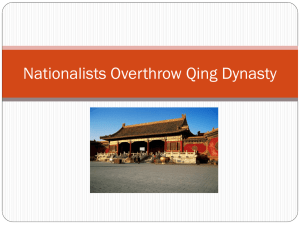Chinese Revolution & Civil War
advertisement
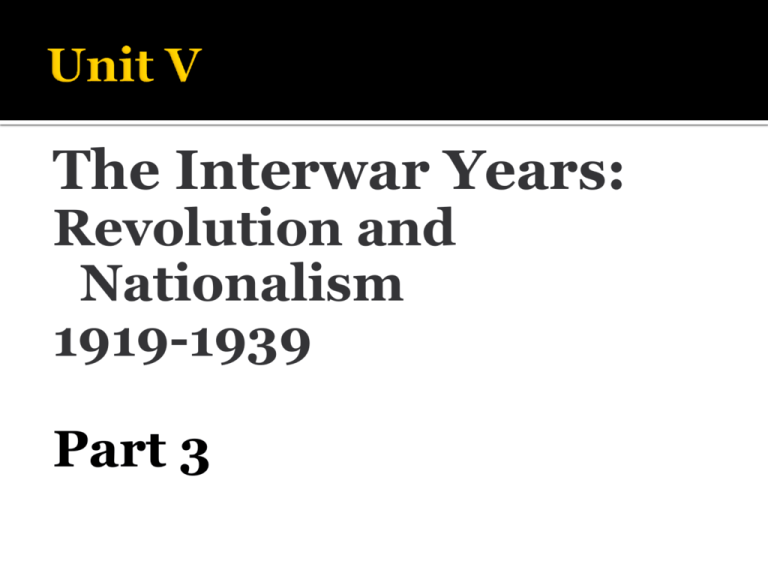
The Interwar Years: Revolution and Nationalism 1919-1939 Part 3 The Collapse of Imperial China Leads to Revolution and Civil War 1900-1949 Kuomintang = Nationalists Sun Yixian (Soon yee shyahn) Formerly Sun Yat-sen Leader of Kuomintang (Kwoh Mihn TANG) Jiang Jieshi (Jee-ahng jee-shee) Formerly Chiang Kai-shek Mao Zedong (MOW Dzuh-dahng) Formerly Mao Tse Tung Leader of Nationalists Leader of Communists China’s trade and resources controlled by foreigners. Chinese nationalists pressed for modernization and wanted to end humiliation of foreign control. Most prominent nationalist group was the Kuomintang or Nationalist Party. The Kuomintang overthrew the Qing dynasty, which had ruled China since 1644, and established a republic. Kuomintang were led by Sun Yixian. Sun wanted a modern government based on “three principles of the people”: Sun Yixian Nationalism (end of foreign control).(Soon yee shyahn) “Father of Modern People’s rights (democracy). China” People’s livelihood (Economic security for all). • Sun gave up power after only six • • • • weeks. Did not have the support of the military and couldn’t unify the country. General Yuan Shikai succeeded Sun and ruled as military dictator. Local revolts against Yuan’s rule. Civil war broke out after Yuan’s death in 1916. Local warlords divided up China as their armies terrorized the countryside. Peasants suffered. General Yuan Shikai (yoo-ahyn shee-ky) • China joined war against Germany, mistakenly believing that grateful Allies would return control of China to the Chinese. • Allies gave Germany’s Asian colonies to Japan, not China, after the war. • Led to widespread protests against Treaty of Versailles and European imperialists. Student outrage over China’s treatment under Treaty of Versailles led to widespread protests. Many young Chinese turned against Western democracy. and embraced communism as a better model for social and economic change. China’s Communist Party formed in 1921. Mao Zedong was one of its founders. • Western democracies refusal to aid Sun Yixian, which led him to seek Soviet support and ally with China’s communists. • Lenin sent military aid and advisors in return for what? Chinese communists being allowed to join Kuomintang . • Sun died in 1925. Chiang Kai-shek • (Jiang Jieshi) became leader of Nationalists. • Jiang waged successful war against warlords (“Northern Expedition”) • Jiang and his capitalist supporters opposed communism. • Jiang set out to purge Kuomintang of the Communists. Generalisimo Jiang Jieshi (Chiang Kai-shek) • Large-scale purge of Communists from the Kuomintang in Shanghai, ordered by Jiang. • Arrests and executions of prominent Communists / union leaders spread across China. • Thousands were killed. Communist Party almost wiped out. • The few Communist survivors (Mao Zedong included) went into hiding. Executions of Communists by Nationalist forces, Shanghai 1927 Jiang Jieshi became president of “Nationalist Republic of China.” Nationalist government recognized by Britain and U.S., but not Russians. Nationalist government corrupt and undemocratic. Modernized cities but did nothing to help China’s peasants. Peasants supported communists, who gave them land. Jiang Jieshi Full-fledged civil war between Communists and Nationalists by 1930. Communists led by Mao Zedong Based in the countryside. Recruited peasants for Red Army. Trained them in guerilla warfare. Attacked Nationalist forces from Mountain hideouts. Mao Zedong Communist forces surrounded by 700,000 Nationalist troops. 87,000 Communists escaped and fled on the hazardous 6,000 mile “Long March.” Crossed 24 rivers and 18 mountain ranges in year-long flight from pursuing Nationalist forces. 95 percent of Red Army was lost. Only 6,000-7,000 survived. The Long March increased the Communist’s loyalty to Mao and became China’s founding myth. Japan invaded Manchuria in 1931. Nationalist response? Nationalists didn’t resist. Hoped policy of non-resistance would dissuade Japan from attacking all of China. Chiang Kai-shek also believed it was more important to defeat the Communists than fight Japan. Not all Nationalists agreed. Japan launched all-out invasion and bombing of China in 1937. Impact on China’s civil war? Threat from Japan forced uneasy truce between Nationalists and Communists, who temporarily united to fight the Japanese. What happened after WWII ended ? Civil War resumed after Japan’s defeat in 1945. Characteristics Leader Occupied territory Support Government strengths and weaknesses Military Nationalists Chiang Kai-shek Communists Mao Zedong Ruled in the South of China after WWII Ruled in the North after WWII United States Soviet Union Struggled with Promise of land inflation and a failing reform appealed to economy peasants Suffered from weak leadership and poor morale Experienced guerrilla army that was highly motivated Based on this information, explain why the Communists eventually won the civil war in China. China’s nationalist government a U.S. ally in World War II. Dictatorial, corrupt, incompetent government. Lacked support of Chinese people. U.S. supported Jiang Jieshi because he was anti-communist. Received billions in U.S. aid. Jiang Jieshi (Chiang Kai-shek) Chiang Kai-shek, FDR, and Churchill During WWII China in Revolution Part 10/10 Mao established communist government on the mainland – “The People’s Republic of China.” U.S., other Western powers refused to recognize the new government of country we called “Red China” Mao signed friendship treaty with Soviet Union . Nationalists fled to island of Formosa (Taiwan) and set up independent government there. Nationalist China was recognized by U.S. and other Western powers (including the U.N.)
